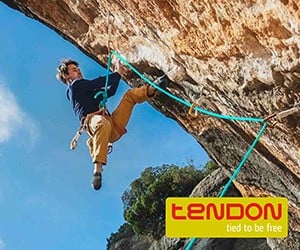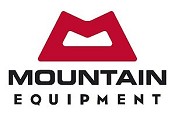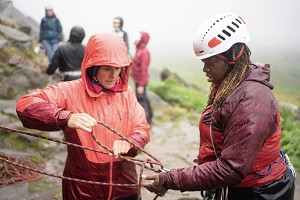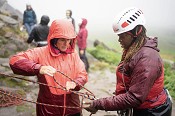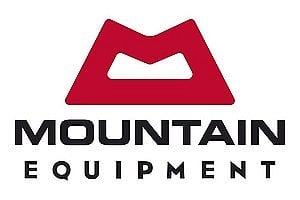

Mick Ward explores the ethos of 'clean climbing' and how it has shaped the equipment we use and the ascents we make.
In the 1960s, Yosemite became a climbing paradise. But what do you do when paradise is threatened with destruction?
In 1972, Chouinard Equipment, run by Yvon Chouinard and Tom Frost, was busy making pitons when it ran into a problem. The problem wasn't their pitons, which were world-class. The problem was damage to cracks caused by pitons – everybody's pitons - being hammered into and out of the same placements. The most obvious damage was in Yosemite where some of the most beautiful cracks in the world were getting trashed.
Excellent stuff Mick.
One small point, that great picture of Dennis Henneck is not of him climbing Half Dome cleanly, he is about to clip a piton and has a hammer dangling from his waist. I think he's topping out on the NA Wall.
Here's the National Geographic cover from the issue featuring Henneck and Robinson's clean ascent of the NW Face of Half Dome: http://www.supertopo.com/photos/2/32/144681_6613_L.jpg
Yes you are right about Mountain 4. I was blown away by the photography. Prior to Mountain the British climbing mags were crap and the photography even worse.
As for the Free-climbing ethic, it was really Pete Livesey & Ron Fawcett who ushered in the clean climbing revolution, often on shorter test prices. But that really is the next chapter in this story.
An enjoyable read Mick!
Hi Duncan and Sean,
Many thanks indeed and apologies for the delay in replying. For a start there seem to be almost as many spellings for Dennis Henneck as Geireagle at Tremadog! Ian Parsons suggests Dennis Hennek.
Ian has also pointed out that the photo is not of doing Half Dome clean. Like you he feels it's the North America wall. To quote him: 'it's at the top of NA Wall [2nd ascent, I think, with Don Lauria...]' He's also pointed out that the FA of the NA wall was 1964 (which I knew - or thought I knew - but forgot). I've loved that photo so much for so long, I just kind of lost track of anything else! It was a stunning winner for the front over of 'Games Climbers Play'.
Incidentally Ken Wilson once mentioned that Drummond's 'Mirror, Mirror', which is the perfect start to 'Games Climbers Play' (divine madness!) was serendipitous. Apparently Dick Swinden casually mentioned it to him. Ken scouted it out - he was always diligent - and the rest, as they say, is history.
Mick
> As for the Free-climbing ethic, it was really Pete Livesey & Ron Fawcett who ushered in the clean climbing revolution, often on shorter test prices. But that really is the next chapter in this story.
It really wasn't, but people love celebrities, and this also applies in climbing.
The adoption of a free climbing ethic was present well before Livesey and Fawcett got going in the early 70s. It was the ethic of the pre-1940s UK climbers so perhaps it never really went away but was just extended to harder climbing in more unlikely venues like quarries and limestone. It was driven by several factors probably including a gradual improvement in gear and acceptance that quarries and limestone were good for free climbing and not just pegging.
In the quarries, Joe Brown freed The Mall and Great North Road in 1957. Many of the easier Millstone and Lawrencefield routes went free in the late 50s and 60s to a variety of people, perhaps most notably Terry King showing the shape of things to come on Regent's Street in 1968. Lancashire saw similar developments with Hank Pasquill freeing Constable's Overhang in 1973 at E5 6b (~Fr 7b). Harder than anything Livesey or Fawcett were climbing at the time.
On the limestone, folk were on the look-out to free old aid routes from at least the late 1950s: High Tor's Original route was first climbed in 1953 then freed in 1958 by Steve Read, Tom Proctor freed Scoop Wall in 1967 and there are many other examples.
Away from the peak, Hamish MacInnes' Engineer's Crack (early 50s) is freed by Kenny Spence in the late 1960s. Ron Moseley part-aided Left Wall in 1956 which goes free by 1972. There are several claimants for the FFA and this is the point: lots of people were trying eliminate the aid and there was kudos in doing so.
These are a few examples of a much more widespread movement. In the 1950s and 1960s many people we doing first free ascents in different parts of the country. It was a revolution in culture, a 'history from below', it didn't take place because of a couple of 'Great Men'.
Perhaps my original post was not very clear. I was essentially referring to climbing in the US and on the continent where aided ascents were much more commonplace. But Livesey & Fawcett really did push the boundaries of bold climbing & free-climbing when they visited these places. The use of bolt protected free-climbing followed afterwards.
Absolutely, Livesey was an habitual self-publicist. I clearly remember some news item in a mag "Livesey and Sheard (?) Had a clean up the Peak weekend" which claimed FFAs of Tut's Anomolous & Great Cleft at Wildcat amongst others.
Stuart Miller and I had free climbed them weeks before and thought nothing of it, I'm sure we weren't the first.
At the end of the article, you say that "Within 15 years, clean climbing would be in ruins", maybe I'm missing something that's already in the article, but what happened in the 15 years following 1972 that led to the ruination of the clean climbing ethic?
> At the end of the article, you say that "Within 15 years, clean climbing would be in ruins", maybe I'm missing something that's already in the article, but what happened in the 15 years following 1972 that led to the ruination of the clean climbing ethic?
Presumably he's referring to the emergence of sport climbing, which in one sense permits even the blankest bits of rock to be bolted without question. Although I do think that such a statement, made in relation to Messner's 'murder of the impossible', should recognise that the acceptance of fixed gear led quickly to a prohibition on its use for physical aid. As such, sport climbing was in fact a healthy response to the 'murder of the impossible', you could say it was a 'redefinition of the impossible'.
As the "best" climbers of their time, they were possibly the most prolific (*) in eliminating points of aid and putting up new routes without any aid but they certainly weren't first, and they still used aid if necessary.
* - Pat Littlejohn might have been even more prolific but not being Peak/Pennine based he wasn't so publicised.
I really enjoyed reading that article, so much I didn't know in there. Some great replies from other UKC members too.
There's a 1964 film by Bob Godfrey on Youtube (think it's been mentioned here) of Eric Jones and Rowland Edwards trying to free Left Wall. According to Mark, Rowland finally managed it and soloed it. (Eric may have freed it as well).
As I'm sure you know (but others may not) Bob Godfrey went on to write 'Climb!', the history of climbing around Boulder. Also made a film of the Naked Edge and one of the FFA of the NW face of Half-Dome - the Dawn Wall of its day.
History is rarely simple. I believe that in 1972 there were four FAs done in the Avon Gorge which later merited E5. I think all were micro routes and not regarded as significant. (They might have been very significant though if you fell off!)
I agree Pete was a self-publicist. And he was ruthless. But I think he did usher in a new attitude in climbing, the sense that anything was possible. And rock climbing started to split away from mountaineering, become a highly valued entity in its own right - much like bouldering is now.
Mick
As John says I'm referring to sport climbing. And sport climbing had to happen. I'm not denying that. And, if I tried, it would be flagrant hypocrisy, given I now spend so much time equipping.
Unfortunately though, dodgy practices seemed to increase in the 1970s and particularly in the 1980s. For instance, chipping and glued on holds. There was one celebrated example of a crucial hold on a cutting edge project being removed by one of the aspirants and replaced when he was trying it. The other aspirant was trying the same project minus a crucial hold.
This kind of behaviour was light years away from what Doug Robinson was proposing with Clean Climbing.
The article is the first of a trilogy. (Yup, there's more coming!) The second part shows what I believe was the collapse of clean climbing, ironically in part through the 'law' of unintended consequences. But I think Robinson's Clean Climbing essay was a poignant cry for ecology. The third part tries to view matters ecological in the present day.
Wittgenstein noted that if you could ask the question you could give the answer. Well, sorry to disappoint mate but I can't. The third part throws up a load of stuff to which I don't have answers - but maybe (hopefully!) you lot will have. Anyway, answers or not, I still think we have to ask the questions which we think matter.
But for years and years, 'thou shalt not wreck the place' has been where my moral compass has pointed. I suspect that Sheridan Anderson, bless him, got something terribly right.
Mick
> Perhaps my original post was not very clear. I was essentially referring to climbing in the US and on the continent where aided ascents were much more commonplace. But Livesey & Fawcett really did push the boundaries of bold climbing & free-climbing when they visited these places. The use of bolt protected free-climbing followed afterwards.
That's certainly what Livesey would like you to believe! There is a teaspoon of truth but it's been frothed up to fill a pint glass. As much as anything it was attitude as Mick says.
US climbers were climbing pretty well in the early 1970s without their guidance. Greasy but Groovy, Shaky Flakes or Space Babble (all 5.11R or ~E5; 1972/3) and Supercrack (5.12d/ 7b+ trad., so hard E5?; 1974) were all at least as hard as anything in the UK and there are many other examples. To be fair to Livesey, he pointed this out in some of his writings at the time.
Livesey and Fawcett created a stir when they climbed in France but free-climbing had already started when they got there. Jean Claude Droyer credits a BMC international meet in Wales in 1971 with opening his eyes to the possibilities: youtube.com/watch?v=Tl0lJTjLjlY&t=55 (The Saussois episode of Seb Bouin's vintage rock tour series, the whole film is great). Livesey and Fawcett may have helped the style gain acceptance in France but that was the way the wind was blowing.
Left Wall free circa1964? I doubt it was that early Mick. I recall Steve Weunch walking up there to have a go at an aid-free ascent in 1970 (as well as Great Wall on Cloggy) when I was dossing in Humphries bunkhouse. He thought he had got the FA but was beaten to it by Aid Garlick? Roland Edwards did managed Resurrection but resorted to some aid. Zeta had just been done by Tony Willmot on Dinas Mot, but again some aid on that top overhang. I repeated it with Bob Millward shortly afterwards, alas not free. Many of the harder routes at the time still made use of some aid, but I remember it was Livesey's Right Wall ascent that really set the pattern for future aid-free climbing first in the UK then elsewhere. Mountain was full of all these multi-bolted ladders in the Alps, (and hence Messner's reaction with his famous article) and the piton ruled in America. But visiting Brits applying the use of nuts in the US switched on a light. Besides many US climbers realised that this continual use of pegs was wrecking the crags. All this development as well as better training & equipment (belay plates, harnesses & EBs) really encouraged the move everywhere towards aid-free climbing in the 1970s.
Re Left Wall, I'm not sure exactly what the sequence was with Rowland Edwards and Eric Jones. But Mark said that Rowland ended up 'working it', kind of as we would now (though not, I think toproping). Mark notes that, as working stuff wasn't a recognised style back then, Rowland never claimed the first free ascent - or first solo ascent.
As Duncan rightly points out above, there are all kinds of fascinating outliers in climbing. The 1960s route which I find utterly outrageous was Our Father, E4 6b in today's money, in 1968. Toproped I believe but not 'worked' as we know it. And a pre-placed thread (and peg?) But of course you can boulder out that bottom overhang at about V4/V5 and after that it's probably 'only' F6b+/6c. Still, an amazing feat though - and in old PAs/EBs. Yikes!
Obviously back then VS was a highly respectable grade. And there was a good reason for that - don't fall off! But things were going to change - and fast.
Mick
P.S. At about 85 and nearly 60 years later Rowland is still doing first ascents of trad routes as hard and harder than Left Wall.
With regards to Our Father, I'm sure I remember somebody told me that Tom Proctor used to solo the start in hush puppies (or something similarly ridiculous) to show people the way to do the sequence that they were failing (or should that be flailing) on.
Apparently he was famous for it, though I don't remember seeing him. He probably had that start wired. You could get it wired. I must have bouldered it at least half a dozen times before I summoned up the gumption to put a rope on. (And I have a sneaky feeling that Paul Mitchell may have clipped the peg for me. If so, naughty!)
There was a very definite point of no return (well, unless assisted by gravity). We used to think nothing of jumping off just before it. Onto that limestone pavement. Ouch! Nobody in their right mind would do that these days.
Our Father (F6c+/7a??), with only two runners (gulp!) always seemed like the shape of things to come: steeper, harder and more intimidating than any other 1960s route I can think of. Even to imagine it could be possible... an amazing feat by Tom Proctor.
Mick
It's always been above my punter's pay grade but when I started climbing in the mid 70's it still had a fearsome reputation.
> Excellent stuff Mick.
> One small point, that great picture of Dennis Henneck is not of him climbing Half Dome cleanly, he is about to clip a piton and has a hammer dangling from his waist. I think he's topping out on the NA Wall.
> Here's the National Geographic cover from the issue featuring Henneck and Robinson's clean ascent of the NW Face of Half Dome: http://www.supertopo.com/photos/2/32/144681_6613_L.jpg
I used to have that edition. Must have a look for it.
Please help UKClimbing continue to provide varied and free content by becoming a UKC Supporter, or UKC Supporter Plus which includes discounted products from Rockfax.
Become a Supporter
